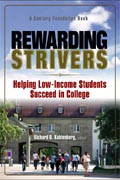Study: Low-income students still unlikely to attend selective colleges
 Researchers Anthony Carnevale and Stephen J. Rose rocked the academic world in 2004 with their landmark study that showed students from the lowest socioeconomic quartile were 25 times less likely to enroll in the most selective colleges than their wealthier counterparts. In response to those findings, several highly respected universities changed both their admissions and financial aid policies in order to attract more low-income applicants. Public policy supported those efforts by making more federal and state financial aid available to low-income students.
Researchers Anthony Carnevale and Stephen J. Rose rocked the academic world in 2004 with their landmark study that showed students from the lowest socioeconomic quartile were 25 times less likely to enroll in the most selective colleges than their wealthier counterparts. In response to those findings, several highly respected universities changed both their admissions and financial aid policies in order to attract more low-income applicants. Public policy supported those efforts by making more federal and state financial aid available to low-income students.
But a new analysis by Carnevale, co-authored with Jeff Strohl, shows that despite these efforts, social, ethnic and racial stratification remains high. Their latest findings, published in the new book Rewarding Strivers: Helping Low-Income Students Succeed in College, suggest that even more stratification has resulted from higher admissions standards put in place recently at selective universities. These standards are rooted heavily in standardized test scores, stacking the deck against minority and low-income students who have historically scored low on tests such as the SAT and ACT.
According to Carnevale and Strohl’s analysis, students from the lowest socioeconomic quartile accounted for just 3 percent of students at the most competitive institutions in 1982. Nearly a quarter century later, in 2006, they accounted for only 5 percent. “If this were K-12 education, we’d be in court” over the differences in how low-income and other students are treated in what he called a “dual system” of higher education, Carnevale told Inside Higher Education.
Given the lack of progress in moving low-income and minority students into selective colleges, it might make more sense to improve the quality of the institutions they do attend, Carnevale said. “Instead of continuing to struggle to move more students into selective colleges where the high-priced quality programs reside, we may be more successful moving money and quality programs to the community colleges where most of our students reside,” he and Strohl write in the book.
Categories: Continuing the Conversation
